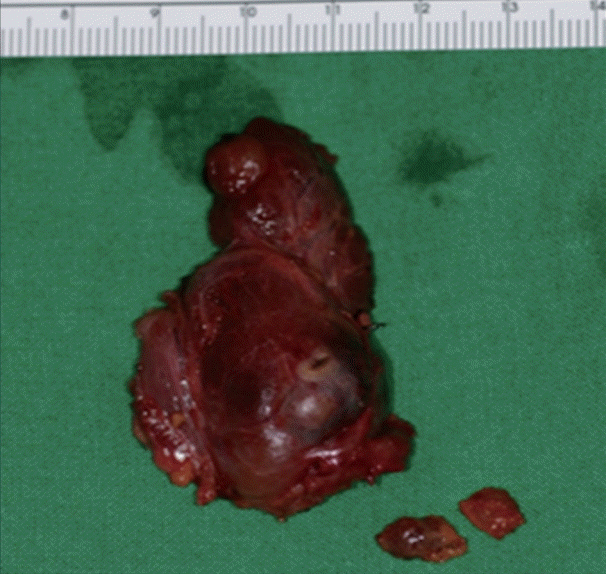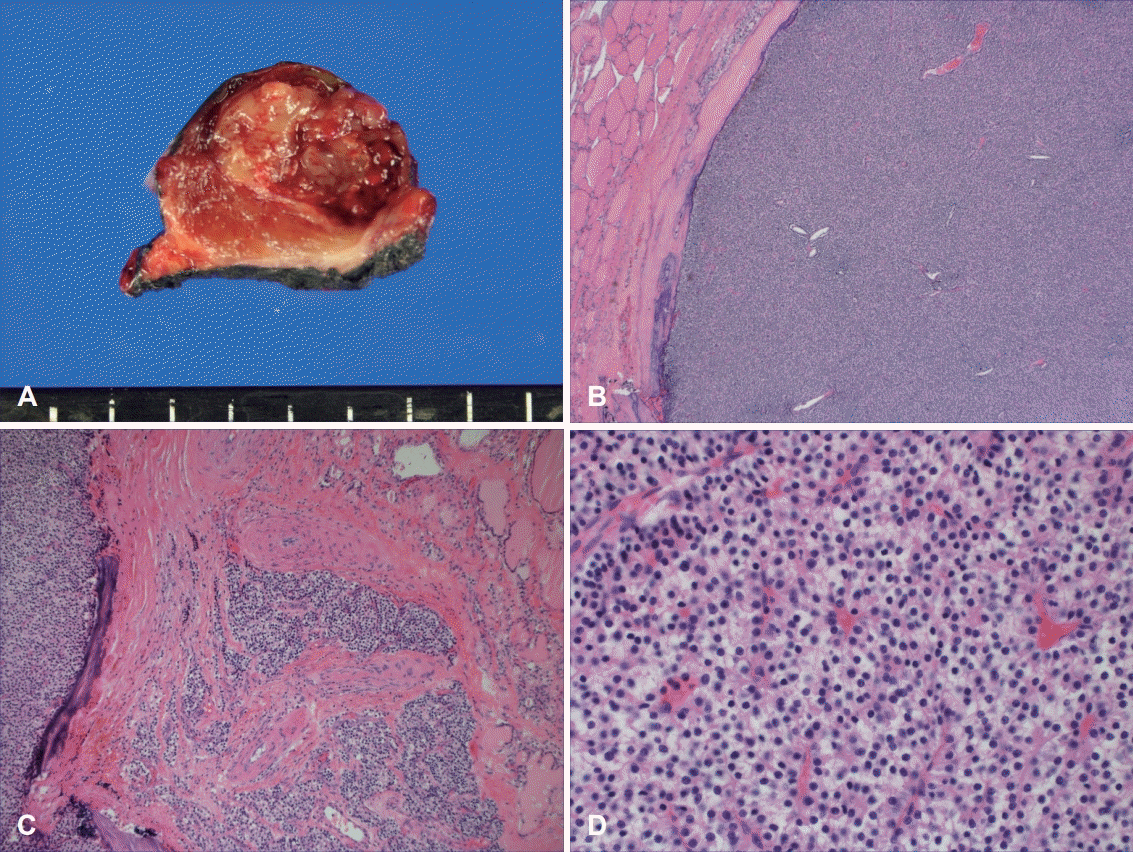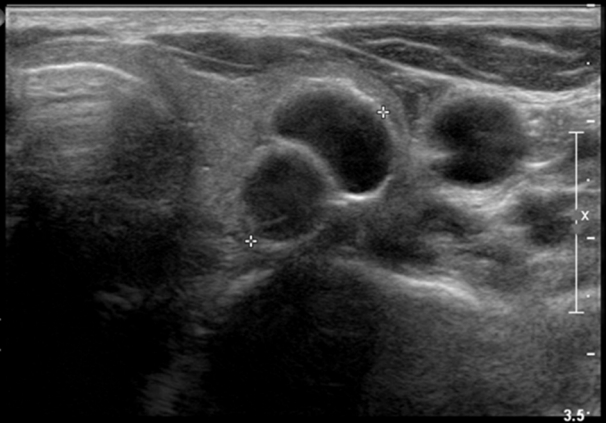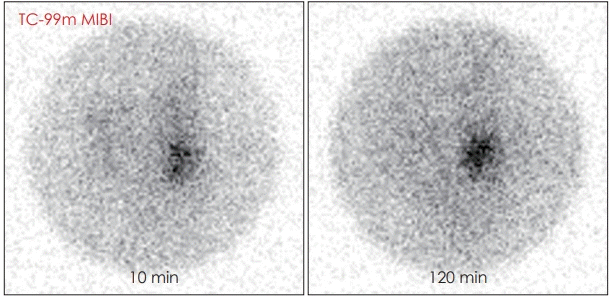Introduction
Case
 | Fig. 3.Operative findings. A 2.5×1.5×1.0 cm mass was found in the left lobe of the thyroid gland, and several enlarged lymph nodes were found at the left paratracheal region. |
 | Fig. 4.Pathologic findings. The gross cut surface shows a yellowish irregular mass confined tothe thyroid gland (A). An encapsulated mass was found in low magnification view (B: H&E stain, ×40), Tumor cells invading into the thyroid gland parenchyma through the capsule (C: H&E stain, ×100), The mass consists of chief cells with moderate dysplasia andis compatible with parathyroid carcinoma (D: H&E stain, ×400). H&E: hematoxylin and eosin. |
Discussion
Table 1.
| Case | Age/sex | Presentation | Past history | PTH level | Tumor location/size | Cytologic diagnosis | Frozen biopsy | Treatment | Outcome, f/u |
|---|---|---|---|---|---|---|---|---|---|
| Ernst et al. [17] | 52/F | Hyperparathyroidism, hypercalcemia | Nephrolithiasis | - | Lt. thyroid/2.5 cm | - | - | Thyroid lobectomy | NED, 4 months |
| Crescenzo et al. [18] | 60/F | Left neck mass, hyperparathyroidism, hypercalcemia | Gastric ulcer, nephrolithiasis | 205 | Lt. thyroid/1.5 cm | Follicular thyroid neoplasm | Parathyroid carcinoma | Thyroid lobectomy, isthmusectomy | NED, 8 months |
| Kirstein and Ghosh [19] | 74/M | Hyperparathyroidism | CKD, hypertension, CHF, COPD | 652 | Lt. thyroid/- | - | - | Thyroid lobectomy | - |
| Schmidt et al. [20] | 76/F | Hyperparathyroidism, hypercalcemia | Asthma, HTN, DM, CAD | 580 | Rt. sup. thyroid/3.2 cm | - | Parathyroid carcinoma | Total thyroidectomy | NED, 1 year |
| Hussein et al. [21] | 63/F | Hyperparathyroidism, hypercalcemia, body aches, fatigue, constipation, reflux disease | HTN, nephrolithiasis, depression, renal insufficiency | 760 | Lt. thyroid/6.0 cm | - | - | Thyroid lobectomy | NED, > 1 month |
| Foppiani et al. [22] | 67/F | Hyperparathyroidism, hypercalcemia, multinodular goiter | Lt. hemithyroidectomy for nodular goiter | 721 | Rt. thyroid/3.0 cm | - | Thyroid lesion with pleomorphism | Total thyroidectomy | NED, 5 years |
| Temmim et al. [23] | 63/F | Hyperparathyroidism, hypercalcemia | Hypertension, nephrolithiasis | - | Lt. thyroid/6.0 cm | - | Benign thyroid tissue | Total thyroidectomy | NED, 2 years |
| Herrera-Hernández et al. [24] | 14/F | Hyperparathyroidism, hypercalcemia | Polyarthralgia, muscle atrophy, joint deformity | 2792 | Right thyroid/2.5 cm | - | - | Thyroid lobectomy | NED, 18 months |
| Kruljac et al. [25] | 40/M | Hyperparathyroidism, hypercalcemia | Nephrolithiasis | 989 | Lt. thyroid/3.1 cm | Poorly differentiated thyroid follicular carcinoma | Medullary thyroid carcinoma | Total thyroidectomy, MRND | NED, 10 months |
| Vila Duckworth et al. [26] | 51/F | Hyperparathyroidism, hypercalcemia | - | 579 | Rt. Inf. thyroid/1.4 cm | Indeterminate for follicular neoplasm | - | Total thyroidectomy, parathyroidectomy | NED, 2.5 years |
| Lee et al. [27] | 59/F | Hyperparathyroidism, hypercalcemia | MEN type I | 248 | Rt. thyroid/2.1 cm | Follicular lesion | - | Thyroid lobectomy | - |
| You et al. [28] | 33/F | Hyperparathyroidism, hypercalcemia | Nephrolithiasis | 965 | Lt. thyroid/6.0 cm, Rt. upper parathyroid gland/0.8 cm | - | - | Total thyroidectomy, upper right parathyroidectomy | - |
| Tejera Hernández et al. [29] | 25/M | Hyperparathyroidism, hypercalcemia | Osteogenesis imperfecta | 800 | Rt. thyroid/2.0 cm | Follicular thyroid neoplasm | - | Thyroid lobectomy | NED, 16 months |
| Balakrishnan et al. [30] | 60/F | Hyperparathyroidism, hypercalcemia | Schizophrenia | 1721 | Rt. thyroid/3.6 cm | Parathyroid lesion | - | Total thyroidectomy | NED, 6 months |
| Ji et al. (present case) | 53/M | Hyperparathyroidism, hypercalcemia left neck mass | HTN, DM, CKD | 3115 | Rt. thyroid/1.8 cm | Parathyroid lesion | Parathyroid lesion | Thyroid lobectomy | NED, 3 years |
NED: no evidence of disease, CHF: congestive heart failure, COPD: chronic obstructive pulmonary disorder, HTN: hypertension, DM: diabetes mellitus, CKD: chronic kidney disease, CAD: coronary artery disease, Sup.: superior, MEN: multiple endocrine neoplasia, PTH: parathyroid hormone, MRND: modified radical neck dissection




 PDF
PDF Citation
Citation Print
Print





 XML Download
XML Download